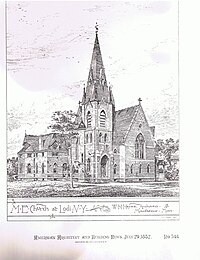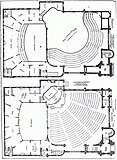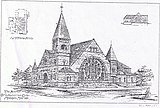|
Warren H. Hayes
Warren Howard Hayes (1847–1899) was a leading designer of churches in the United States and Canada during the late 19th century. Hayes' work holds a significant place in its association with the "Social Gospel" movement. He is credited with some of the earliest use of the "diagonal auditorium" plan and the vast majority of his churches uncovered to date are centered on the diagonal auditorium design with fan shaped pew arrangements and, to assure excellent acoustics, the seating sloping toward the pulpit and domed ceilings. As noted at the opening of the Rockville Ct. Congregational Church:
Often the interiors have Arts and Crafts movement attributes, and some of the congregations accepted Hayes recommendations of Louis Tiffany for their stained glass. From early in his career Hayes worked closely with artists-decorators, such as Lawrence A. McIvor, who worked for Hayes in Elmira, and later followed him to Minneapolis where he worked as the L.A. McIvor & Company.[3] While attentive to the look and sounds of his churches, Hayes also was an early adopter of advanced mechanical and electrical systems.[4] The National Register of Historic Places currently includes seven of his works in Minnesota[5] and the Methodist Episcopal Church at Lodi, New York. Hayes was deeply involved in the institutional church movement throughout his career, and although he was a Methodist, he had extensive ties with other denominations. This is well illustrated in the nationwide dissemination by various church organizations charged with promoting church building and development of his ideas and plans in the late 19th century. LifeThe National Cyclopaedia of American Biography included a lengthy entry about Hayes, together with some family background, five years before his death:[6] On his father's side he is of New England stock, being descended from George Hayes, of Windsor, Connecticut, who emigrated from Scotland to Derbyshire, England, and thence to Windsor, Connecticut, in 1680, where descendants of the family still live. Many honored names represent the family in professional and official life, 19th President of the United States Rutherford Hayes being among the number. Upon his mother's" side, Mr. Hayes' progenitors are the Robsons and Straughans, of Northumberland, England, who emigrated to Geneva in Ontario, early in the nineteenth century. The boyhood of Mr. Hayes was spent on the farm of his father, George Goundry Hayes, who was at that time one of the most successful agriculturists in that section, owning and tilling large farms in Yates, Steuben, and Ontario. The son's studies were begun at the age of five in the district school, and continued for seven years. This was supplemented at the select school in Italy, New York, at Watkins' Academy, and at Genesee Wesleyan Seminary at Lima, New York. In 1868 Hayes entered the sophomore class of Cornell University, and was graduated in 1871, having successfully taken the courses in architecture and civil engineering, including the natural sciences and modern languages. He also, during his college course, took two President Andrew Dickson White, who was the founder of the Department of History and Political Science, first prizes for proficiency in mechanics and physics. The succeeding ten years were given to the successful practice of his chosen profession, architecture, at Elmira, New York, where, in May 1881, he was united in marriage to Miss M. F. Beardsley. In September 1881, he opened an office in Minneapolis, Minnesota, where from that time to 1894, he has maintained a widely extended and successful practice. Many of the finer business and public buildings in Minneapolis and St. Paul have been erected by him, as well as notable structures in other cities. Hayes shows especial originality in ecclesiastical architecture. Among the churches which he has designed are the First Congregational Church at Rockland, Massachusetts, the Union Congregational Church at Rockville, Connecticut, the First Baptist Church at Portland, Oregon, and the Wesley Methodist Episcopal Church in Minneapolis, Minnesota. At the present time Hayes has in process of erection the Fowler Methodist Episcopal Church, a most complete and finely equipped edifice, and named for Bishop C. II. Fowler and now known as the Scottish Rite Temple. All the above buildings, and many similar ones, notably the Central Presbyterian Church of St. Paul, Minnesota, and the First Presbyterian Church of Galesburg, Illinois, are planned on Hayes' original "diagonal plan" of auditorium, developed by him in the winter of 1882, and first used in several leading churches in Minneapolis. Its beauty and success were popular from the first. It has become widely known and used, until now it may justly be said to be the most practical and successful form of church auditorium known in modern architecture. It insures superior qualities with respect to Acoustics, facilities for sight, ventilation, light, access, and ease of combination with the chapel, bringing all within sight of, and within short distance from, the speaker. The diagonal auditorium is the result of much study on the part of the originator, to whom it has brought great credit and enduring fame. On October 26, 1886, Hayes was married to Mrs. Lillie Cook Van Norman, of Hamilton, Ontario, his first wife and daughter having died four years previous. From this second marriage three children were born to them: Edith, George Edson, and Helen, who, with Mary Van Norman, the stepdaughter, form the present family. [mention of his daughter Alice Grace Hayes (Smith) unfortunately was omitted].[6][7] An article at the time of his untimely death in 1899 from pernicious anemia noted:
After Hayes' death his architectural business was purchased by Frederick H. Heath, who began his architectural studies in Hayes office and who worked as a draftsman and designer for Hayes for ten years.[9][10] Heath went on to a very distinguished career and designed hundreds of buildings in the Tacoma, Washington area.[11] Church architectureIn 1997, Ronald Ramsay, then Associate Professor at North Dakota State University, visited the Presbyterian Historical Society and studied various annual reports of the Board of Church Erection for the Presbyterian Church U.S.A. and reported a list of Hayes designs to the Hayes Research Project that included nine designs and renderings by Warren H. Hayes, as follows:
Often these Hayes' designs were accompanied by a note ("Plans, detailed drawing, specifications, and form of contract all complete, ready to be sent, by mail, on receipt of $5.00") Hayes also advertised in the Presbyterian "Assembly Herald".[22] Hayes had an extensive relationship with the Congregational Church Building Society, the American Congregational Union. His advertisements appeared frequently in its Church Building Quarterly[23] and on occasions there appear announcements regarding various churches Hayes' had designed.[24] St. Louis Compton Hill Congregational Church[25] Morning Sun Iowa Congregational Church;[26] Plymouth Congregational Church, Oshkosh, Wisc.;[27] Eagle Grove Iowa Congregational Church;[28] First Congregational Church in Salt Lake City, Utah;[29] Wausau, Wisc.[30][31] As noted by Jeanne Halgren Kilde in her book When Church Became Theater: The Transformation of Evangelical Architecture ... (2002) (p. 105) "[...] Hayes [...] gained the imprimatur of the National Council of Congregational Churches during the 1890s when he was the architect most often featured in the Congregational Yearbook."[32] Similarly, Hayes advertised in the Baptist Home Monthly, and had many commissions for Baptist churches.[24] Sommerville, Mass. Union Baptist Church[30] The Methodist Church likewise published Church Plan catalogs[33] In effect these church building societies were putting together "plan books" or plan exemplars and sending them to their members on a regular basis. While Hayes is best known for some of the larger churches he designed, many of the participants in these building societies were small churches, which logically gravitated to such 'off the shelf design'. Often local architects would use these plan book designs, or would be required by local ordinance, custom, or oversight duties to adopt the plans as their own. An example of this approach is the construction of the Congregational Church of St. Joseph, Missouri. While Hayes designed the church, --- as evidenced by his rendering in the October 1890 edition of the "Church + Building Quarterly" of the American Congregational Union.[34] — all of the public filings, and the all important architect's signature and seal were done by local St. Joseph, MO. professionals. See also Hayes advertisement including a rendering of the St. Joseph Mo Congregational Church.[35] This process of the use of plan books, and transmission via the mails of standard designs, together with local oversight often can cause great confusion in giving the correct attribution to a particular church. This appears especially to be the case with Hayes, and it may be that literally hundreds of churches built during the 1880s and 1890s are his design. Indeed, if one finds a church 'diagonal auditorium' design of that vintage, with curved floors for better acoustics, it could well be a Hayes' church. Works  After graduation from Cornell, Hayes set up his office first in Penn Yan and then in 1873 in Elmira, New York. One of his earliest published designs is an 1878 English cottage that appears in the American Architect and Building News.[36] Another example of Hayes' early residential works is his father's home built in about 1883 at 2505, County House Road, Penn Yan, NY, which is now on the National Register of Historic Places, and where inscriptions noting the design work signed by Hayes have been found. Hayes designed his Minneapolis home at 619 12th Avenue South. The last known example of a Hayes residential commission appears in The Improvement Bulletin of June 24, 1899, which reported that Hayes had prepared plans for a 2-story frame residence to be erected by Rev. T. M Findley at Spicer, Minnesota.[37] Hayes' first known church commission was the First Methodist Church of Watkins Glen, at 127 E. 4th Street, Watkins Glen, NY 140891.[38][39] Noting that Hayes went from a
This was no doubt due to his close ties to the community. Hayes' uncle, Daniel Howard, was the President of the Board of Trustees. The church also has a stained glass window in memory of Daniel A. and Hannah Howard. Other churches designed while at Elmira include the Methodist Episcopal Church at Lodi, New York, featured on the cover of the July 29, 1882 edition of the American Architect and Building News (No 344), and now on the National Register of Historic Places. In Minneapolis, Hayes designed the Calvary Baptist Church, the Fowler Methodist Episcopal Church (in 1906 the original sanctuary was converted into a Chapel as part of a substantial church expansion designed by Harry Wild Jones, which retained the Sunday school rooms which are now part of the 'Red Room' of the Scottish Rite Temple, which has the original plans, with copies at the Northwest Architectural Archives), the First Congregational Church, and the Wesley Methodist Episcopal Church.[41]
Elsewhere in Minnesota, Hayes designed the Central Presbyterian Church in Saint Paul. Hayes' design of a Church for the First Methodist Church Society of Beijing, China, with seating capacity for 2000, was almost as large as his Wesley Methodist Church.[42][43]
Hayes also prepared designs for institutions and developers. Examples include the Science Hall at Hamline University, University Hall-Old Main at Hamline University, Ladies Hall at Lawrence University in Appleton, Wisconsin, and the Music Building at the University of Minnesota.[44] Examples of his furniture designs also still exist, such as an octagonal table inscribed "Designed and Built for Warren H Hayes, Architect, 1893" and signed by Hayes.
PublicationsNumerous elevation and plan view renderings by Hayes appeared in professional and trade journals of the 1880s and 1890s, for example:
The Improvement Bulletin also noted the following works by Hayes:
References
External links
|
||||||||||||||||||||||||||||||||||||||||||||||||











